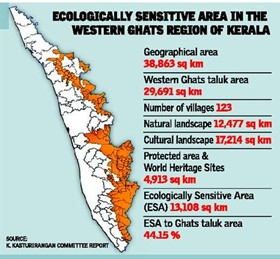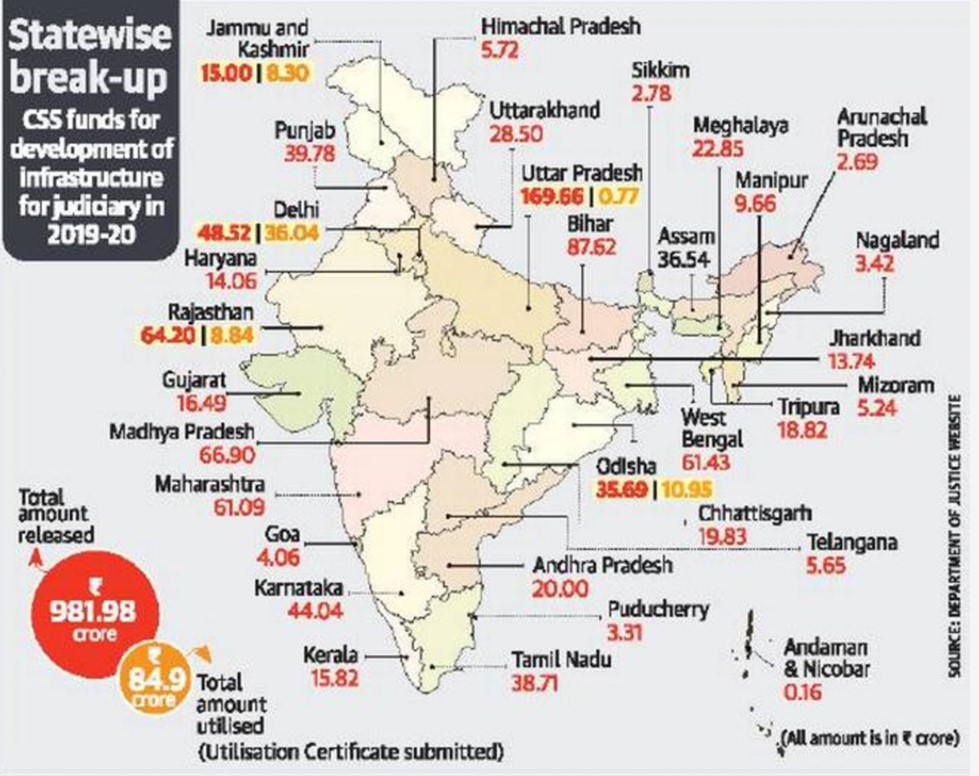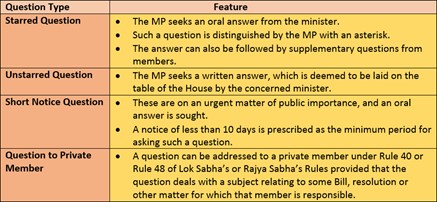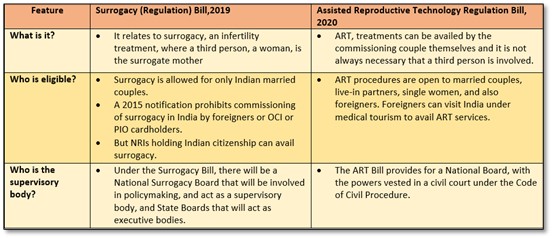Thursday, 9th December 2021
Chief of Defence Staff (CDS)
In News
The first CDS of India, General Bipin Rawat died after a military chopper crashed in Tamil Nadu.
Formation of CDS role
- Kargil Review Committee (KRC), 2000 recommendations: Constituted in the immediate aftermath of the 1999 Kargil war to examine lapses that allowed Pakistani soldiers to occupy strategic heights, the K Subrahmanyam-led KRC had first recommended the creation of a CDS as a means to provide single-point professional military advice to the political leadership and to also achieve synergy in the working of the three forces.
- Group of Ministers (GoM) review report, 2001: GoM set up in April 2000 to review national security in its entirety, with particular focus on the recommendations of the KRC, backed the creation of the post of CDS.
- Creation of the post: In August 2019 the post of CDS was created with the purpose to act as the Principal Military Adviser to the defence minister on all tri-services matters so as to provide impartial advice to the political leadership.
- After the appointment of the CDS, the armed forces were brought under the ambit of the Department of Military Affairs (DMA).
- The CDS is a four-star general belonging to any of the three sectors of the Indian Armed Forces and his salary is equal to that of a service chief.

Functions of CDS
- To head DMA in Ministry of Defence and function as its secretary.
- To act as the principal military advisor to the defence minister on all tri-service matters.
- To function as the Permanent Chairman of the Chiefs of Staff Committee
- To be a member of Defence Acquisition Council chaired by the defence minister
- To function as the Military Advisor to the Nuclear Command Authority.
- To bring about jointness in operation, logistics, transport, training, support services, communications, repairs and maintenance, etc of the three Services.
- To ensure optimal utilisation of infrastructure and rationalise it through jointness among the Services.
- To implement Five-Year Defence Capital Acquisition Plan and Two-Year roll-on Annual Acquisition Plans, as a follow up of Integrated Capability Development Plan.
- To bring about reforms in the functioning of three Services with the aim to augment combat capabilities of the Armed Forces by reducing wasteful expenditure.
- Mandate to raise Theatre Commands in India to create integrated tri-Services command in India.
What Next for the post of CDS?
- A CDS can serve till the age of 65 while the three Service Chiefs either serve till they attain the age of 62 or for three years in the post.
- Shekatkar committee recommendation says the government should choose the CDS from among the three service chiefs, while many believe that the early 2-3 CDS should come from Army.
- As per the rules, any Commanding officers or flag officers of the armed forces are eligible for the position.
- With the passing of General Bipin Rawat, with a year remaining in his tenure, it has created an unforeseen situation for the security establishment. With no clear no clear line of succession, the Cabinet Committee on Security will decide on next CDS.
Where can it be used?
- CDS, Military Reforms
Sources:
World Inequality Report 2022
In News
‘World Inequality Report 2022’, the flagship report by World Inequality Lab has found that India is among the top unequal countries in the world in terms of Income and Wealth distribution.
About the Report
The aim of the World Inequality Report 2022 is to present the latest data available on inequality to inform democratic debate globally. It updates the 2018 World Inequality Report, adding new data with
- Gender dimension in terms of share of income earned
- Environment dimension in terms of carbon emissions by each section
- Tax justice dimension in terms of remedies that may help reduce inequality.
Observations regarding World inequality
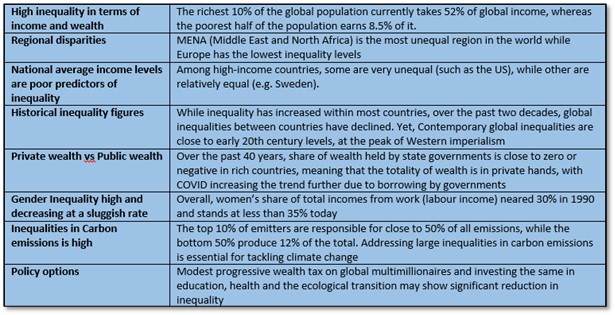
Status of India
- Income inequality: The top 10% and top 1% hold respectively 57% and 22% of total national income, the bottom 50% share has gone down to 13%.
- Thus, India stands out as a poor and very unequal country, with an affluent elite.
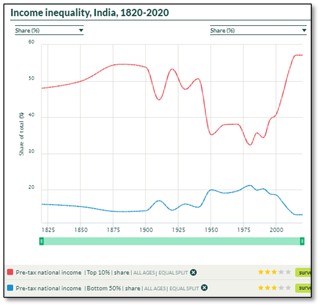
- Wealth Inequality: The bottom 50% own an average wealth of 6% of the total, the middle class has an average wealth of 29.5% of the total as compared with the top 10% and 1% who own respectively 65% of the total 33% of the total household wealth of the nation.
- Gender inequality: Gender inequalities in India are very high. The female labor income share is equal to 18%, one of the lowest in the world. This is significantly lower than the average in Asia (21%, excluding China).
- Carbon inequality: India is a low carbon emitter where the average per capita consumption of greenhouse gas is equal to just over 2 tCO2e. These levels are are quite low as compared to the world.
- The bottom 50%, middle 40% and top 10% respectively consume 1, 2, and 9 tCO2e/capita.
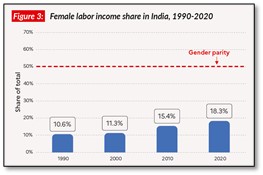
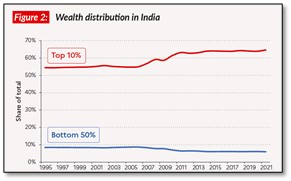
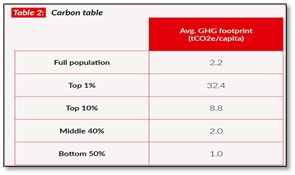
Where can it be used?
- Inequality, Societal problems, Economy
Sources:
High LPG Prices vs the Air Pollution
In News
The price of LPG refills has risen by more than 50% to over ₹900 per cylinder this year compared to around ₹600 over the past year.
About the News
- To tackle the menace of cooking fuel induced pollution, the Government had taken several measures like Pradhan Mantri Ujjwala Yojana scheme for distribution of subsidised LPG connections.
- Nearly 85% of Indian homes have an LPG connection and 71% use it as their primary cooking fuel, compared to only 30% a decade back
- But, the sustained rise in the price of LPG cylinders has been a huge burden in many a household budget for more than a year now.
- Easy availability of free biomass and lack of home delivery of LPG refills further reduce the efficacy of LPG as a reliable and affordable proposition.
What can be done to sustain the LPG uptake?
- Cover the entire spectrum of household: The practice of biomass usage that is predominantly concentrated in rural areas particularly Bihar, Jharkhand, Chhattisgarh, Madhya Pradesh etc and Urban slums that are critical hotspots of biomass usage have to be plugged at the earliest.
- Reinstating Subsidies: At the current refill prices, an average Indian household would have to spend around 10% of its monthly expense on LPG. Thus, reinstating the subsidies on LPG refill for low-income households becomes critical.
- Boost timely availability of LPG for all consumers: Only half the rural LPG users receive home delivery of LPG refills, while the rest have to travel long to procure a cylinder.
- These gaps in the doorstep delivery of LPG cylinders have to be plugged by strengthening the LPG supply chain and enforcing timely service delivery.
- New market creation for locally available biomass: Households can be incentivised to supply locally available biomass (to Compressed Biogas (CBG) production plants being set up under the SATAT scheme. Such measures would help enhance local income and livelihood opportunities, in turn encouraging rural families to use LPG on a regular basis.
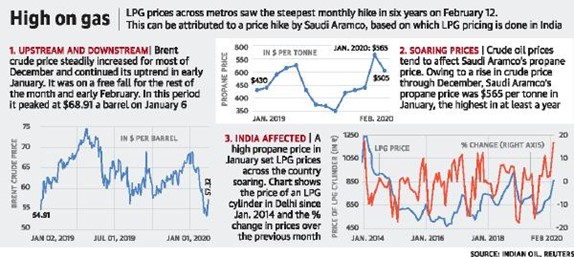
Where can it be used?
- LPG reforms, High Price of LPG, Indoor Pollution
Source:
- High LPG prices are scorching the air pollution fight
- High LPG prices scorching air pollution battle
Image Source:
International Anti-Corruption Day
December 9th has been designated as International Anti-Corruption Day by the UN, to raise awareness of corruption and of the role of the Convention in combating and preventing it. Corruption is a complex social, political and economic phenomenon that affects all countries. Corruption undermines democratic institutions, slows economic development and contributes to governmental instability. Corruption attacks the foundation of democratic institutions by distorting electoral processes, perverting the rule of law and creating bureaucratic quagmires whose only reason for existing is the soliciting of bribes. The theme of the 2021 International Anti-Corruption Day is “Your right, your role: Say no to corruption”

Sources:
Assessment of agricultural plastics and their sustainability
In News
According to a report titled “Assessment of agricultural plastics and their sustainability: A call for action” released by the FAO, plastic pollution has become pervasive in agricultural soils.
Introduction
- Over the last 70 years, the use of plastics in agri-food systems and food value chains has become pervasive. Low-cost and adaptable plastic products have crept into every part of our food systems — from fishing gear and tree guards to greenhouses.
- While they can increase productivity and efficiency in all agricultural sectors and help minimize food loss and waste, plastics are a major source of contamination.
- Soils are one of the main receptors of agricultural plastics and are known to contain larger quantities of microplastics than oceans. With rising demand for agricultural plastics, there is an urgent need to better monitor the quantities of plastic products used and that leak into the environment from agriculture.
The link between Plastics and Agriculture
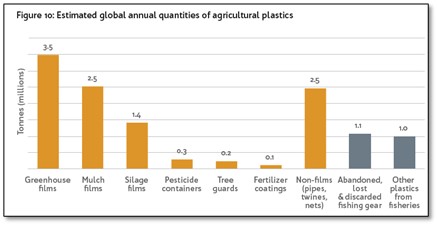
The problems associated with plastics in Agriculture
Despite the benefits, plastics can also be problematic, impairing agricultural productivity in both terrestrial and aquatic environments. Overall, plastic contaminants can enter agricultural systems by two main routes, namely:
- Leakage from non-agricultural sources, such as windblown litter, air-borne pollutants, such as microplastics from tyre wear, unplanned dumpsites, and contaminated flood/drainage waters.
- Leakage from agricultural activities, through agricultural plastic products becoming damaged, degraded, or discarded (the 3D concept) and the application of microplastic contaminated organic amendments and irrigation water.
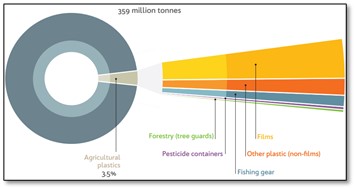
Adverse effects
- Most are single-use products and can persist in the environment for long.
- Microplastics pose an increasing concern through their potential to transfer and accumulate in food chains, threatening food security, food safety, and potentially human health.
- It is also difficult and costly to recycle them: of all plastics produced globally, only about 17% are recycled.
- Plastic mulch films are hard to remove from soils without tearing them and recycling is more difficult due to contamination from soil, plant, and fertilizer residues.
- Accumulation of plastic residues in surface soils is also detrimental to agricultural production. A study carried out in China in 2019 found that application of plastic mulch on soils reduced crop yields by 11-25% after multiyear use.
- Over time, film residue can decrease soil porosity and air circulation, change microbial communities, and potentially lower farmland fertility. Fragments of plastic film have also been shown to release potentially carcinogenic phthalate acid esters into the soil, where they can be taken up in vegetables and pose a human health risk when the food is consumed.
- Larger plastic residues can harm wildlife through entanglement and ingestion. Inappropriate disposal of agricultural plastics at dumpsites prone to fires or open burning on farms create toxic emissions.
- In addition, plastics disintegrate into micro- and nano- plastics, which can leak into oceans and food chains, with potential consequences for food safety and human health.
Quantity of Plastics and Regional Distribution
- In 2019, agricultural value chains used 12.5 million tonnes of plastic products (equivalent to almost 3.5% of the global plastic production of 359 million tonnes in 2018) in plant and animal production and 37.3 million tonnes in food packaging.
- The agricultural plastic industry forecasts the global demand for greenhouse, mulching and silage films to increase by 50% from 6.1 million tonnes in 2018 to 9.5 million tonnes in 2030.
- Asia is the largest user of plastics in agricultural production, accounting for almost half of global usage.
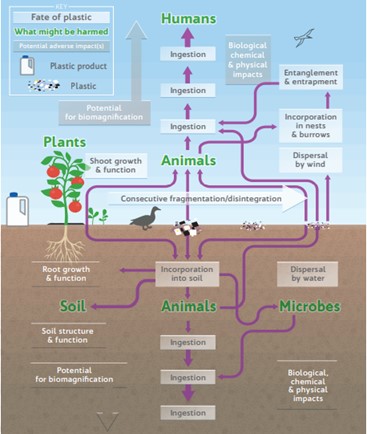
Way Forward
At the international level, the report recommends a two-pronged approach:
- Develop a comprehensive voluntary code of conduct to cover all aspects of plastics throughout agri-food value chains: It should aim to support the transformation towards sustainable agri-food systems considering all the benefits and trade-offs in relation to all dimensions of sustainability.
- Where appropriate, existing international conventions could consider mainstreaming specific aspects of the life cycle of agricultural plastics such as the Basel Convention, beyond just wastes; and the MARPOL Convention for the management of plastics used in fisheries and aquaculture.

Conclusion
Tackling agricultural plastic pollution is paramount to achieving more efficient, inclusive, resilient and sustainable agri-food systems for better production, better nutrition, a better environment, and a better life, leaving no one behind. This will be vital in helping to deliver the objectives of the United Nations Decade on Ecosystem Restoration. It also responds to FAO’s new Strategic Framework 2022-2030 and its programme priority area on Bioeconomy for Sustainable Food and Agriculture, which has a particular emphasis on Sustainable Development Goal 12 – Responsible Consumption and Production, including waste disposal.
Question: Tackling agricultural plastic pollution is paramount to achieving more efficient, inclusive, resilient and sustainable agri-food systems. In this context discuss the challenges of agricultural plastic pollution and solutions.
Where can it be used?
- Soil pollution, agricultural pollution, ecological degradation
Sources:
- Assessment of agricultural plastics and their sustainability: A call for action
- Fields of Plastics
- UN REPORT LAYS OUT ‘STARTLING’ IMPACT OF AGRICULTURAL PLASTICS
- How plastic is infiltrating the world’s soils
- WORKING PAPER- Plastics in agriculture: sources and impacts
- Beating plastic pollution in agriculture – World Environment Day special
300 megapixels Sun
This is 300-megapixel image of the Sun. The image has captured the streams of plasma rising from the Sun’s surface. The photo was able to capture sunspots and active regions called swirls or coronal loops. According to NASA, coronal loops are found around sunspots and in active regions. The composite image shows the “blinding bursts of energy stem from areas of heightened magnetic activity, pushing and pulling on the solar surface and creating fascinating patterns in the atmosphere. Last year NASA released the first images from ESA/NASA’s Solar Orbiter, which included the closest pictures ever taken of the Sun..

Source:
Nizamuddin Basti Project
- Context: The Nizamuddin Basti project has won two UNESCO heritage awards.
- It is an Urban Renewal project started in 2007 that focusses on holistic urban revitalisation of the historic Nizamuddin Basti community in Delhi.
- The Nizamuddin Area comprises the World Heritage Site of:
- Humayun’s Tomb
- The centuries-old settlement of Hazrat Nizamuddin Basti and Sunder Nursery
- 16th Century Batashewala Tomb-Garden Complex
- Tomb of 16th Century courtier poet Khan I Khanan ‘Rahim’and
- The Mughal-period caravanserai of Azimganj Serai.
- The project successfully unified these segregated zones of the conservation area into an urban historic district of considerable cultural significance.
- The project has been awarded for placing heritage at the heart of the sustainable development agenda and through an innovative People-Public-Private Partnership model for overcoming major socio-economic challenges to improve health, education and well-being, particularly for women and youth.

Source:
- Nizamuddin Basti project wins two UNESCO heritage awards
- Started in 2007: Nizamuddin Basti conservation project gets two UNESCO Awards
Image Source:
Swachh Bharat Mission-Urban 2.0
- Context: Ministry of Housing and Urban Affairs (MoHUA) has signed a MoU with UNDP India to strengthen the waste management sector in India under Swachh Bharat Mission- Urban 2.0 (SBM-U 2.0).
- SBM-U 2.0 is the second phase of Swachh Bharat Mission- Urban (SBM-U) launched in 2014.
- It aims to make cities ‘Garbage Free’ and is focused on achieving 100% waste processing along with bio-remediation of legacy dumpsites, construction and demolition waste and plastic waste management.
- It will be operational for a period of 5 years (2021-26).
- Under the mission:
- All statutory towns will become at least open defecation freeODF+:
- All cities with <1 lakh population will become ODF++
- Systems and processes will be in place so that all waste water is safely treated and optimally reused and no untreated wastewater pollutes water bodies.
- All cities will achieve at least 3-star Garbage Free certificationunder SBM-U 2.0 with respect to Solid Waste Management.

Source:
- MoHUA and UNDP sign MoU for Strengthening Waste Management Sector in India under Swachh Bharat Mission-Urban 2.0
- Prime Minister launches Schemes for transforming Urban Areas- AMRUT 2.0 and Swachh Bharat Mission-Urban 2.0
Image Source:
Earth’s Blackbox
· Context: To help understand what steps are being taken towards climate change, an indestructible black box is being built in Australia.
· It will be built and placed on the west coast of Tasmania in early 2022.
· Just like black boxes record flight, ships and cars journeys and provide evidence in case of any accident, this black box will record “every step we take towards the catastrophe”.
· It will record every conversation that’s made towards climate change for future generations to see what actions we took, and how it led to the “demise of the planet”.
· It will be made with 3-inch thick steel and covered with solar panels.
· It will be around the size of a city-bus inside which there will be storage drives that record climate change conversations and also atmospheric carbon dioxide levels and average temperatures.
· The storage drives inside Earth’s Black Box are designed to last for around 30 to 50 years.

Source:
- Earth’s black box will record every conversation and step taken on climate Change for future generation to see
- Mysterious 'black box' in Australia to record every action on climate, hold humans accountable
Image Source:
India’s First Survey Vessel
- Context: The first of the four survey vessels- ‘Sandhayak’ was launched in Kolkata recently.
- These survey ships are capable of full scale coastal & deep-water hydrographic survey of Ports & Harbour approaches and determination of navigational channels & routes.
- They are also capable of undertaking survey of maritime limits and collection of Oceanographic & Geographical data for Defence applications, thus boosting the maritime capabilities of the country.
- These ships are propelled by two Marine Diesel Engines combined with Fixed Pitch Propellers and fitted with Bow & Stern Thrusters for manoeuvring at low speeds during surveys.
- In their secondary role, they would be capable of performing roles such as Search & Rescue and Disaster Relief, besides serving as Hospital ship with limited facilities during emergencies.
- It has over 80% indigenous content by cost and this will boost employment generation and provide thrust to “Make in India”.

Source:
- India’s First Survey Vessel (Large) Launched By GRSE
- GRSE Kolkata launches large survey ship ‘Sandhayak’
Image Source:
The Indo-Pacific economics: Inextricable Chinese linkages and Indian challenges: ORF
Essence: The editorial highlights the fact that Indo-Pacific region remains a lucrative destination for economic opportunities with 60% of world population, 60% of world GDP, 50% of world maritime trade and around 40 countries in the region. The intra-regional economic partnerships amongst countries like China, Japan, South Korea, Australia, Singapore and India provides major linkages for growth. Some of them (Australia, South Korea, Japan) have China as the largest trading partners. At the same time, China provides backward-forward linkages to the regional economies. China happens to be the major source of FDI and infrastructure development (BRI) in many of the Asia-Pacific countries. Due to such linkages, many of these economies think twice before taking any strategic decision that might irk China.
Though India’s trade with 20 of the Asia-Pacific countries has increased 8 times since 2001, with the present value around $250Bn, India’s engagement remains limited due to homogeneity in service sector (IT industries), lagging FDI, few multinationals from India participating in value chains, etc. China’s trade with ASEAN is eight times more than India-ASEAN trade. If India needs to compete and present an economic front for itself at Asia Pacific region, it needs to build technological capacity to compete with economies like South Korea, Taiwan, etc. and at the same time protect its domestic industries from ruthless external competition.
Why you should read this article?
- To understand the interlinkages amongst economies in Asia-Pacific region.
- To gain an insight into China’s economic might in regional value chains.
- To understand India’s position and shortcomings which limit India’s participation in international trade.
Source:
The need for a robust civil registration system: TH
Essence: Mortality data are extremely important for pandemic management. South Africa has established an efficient rapid mortality surveillance system and has established procedures to correct for biases in reporting excess mortality. In case of India, excess mortality estimates are based on epidemiological models. The problem is that there are data biases. In the absence of a reliable estimates, it is difficult to understand the magnitude of pandemic mortality.
However, some recent trends are encouraging. The Civil Registration system (CRS) report indicates high level of registration completeness (though it has certain gaps), there has been prompt release of information on registered deaths by some states and also increased media and public attention to epidemiological data. All these raises a general expectation of continued public attention to health data. But there is still lot to be done like need to establish local statistical capacity, standard data dissemination protocols and near real time surveillance report. These steps will help to establish reliable real time mortality surveillance for pandemic preparedness.
Why to read this article?
- To understand that there is a need of reliable, real time mortality surveillance for pandemic preparedness in India as the COVID-19 advances in the third year.
- To know how India estimates its excess mortality, the recent trends in relation to data, and the future steps needed for mortality surveillance.
- As the COVID-19 advances in the third year and with the coming up of Omicron variant, the article becomes highly relevant from the perspective of GS II (Health) and from the case study perspective (GS IV).
Source:
Farmers’ rights and PepsiCo’s hot potato: HBL
Essence: The article bring attention to the seed and biotechnology innovation sector in India which presents a vague and unfavorable lndian law for innovation and protection for plant and seed varieties. The issue grabbed attention with the revocation of registration granted to Pepsico in favour of farmers’ rights to grow potato crop under the Protection of Plant Varieties and Farmers Rights’ Authority (PPV&FRA) norms.
India is the world’s fifth largest market for seeds, plant varieties and vegetatively propagated varieties. There are few RnD centres but huge participation of private sector for industrial production of seeds and their disbursal from labs to farms.
Though the registration of Pepsico was revoked on the ground of technical and procedural lapses, there seem to have been no transgression of farmers’ rights, contrary to the popular notion. There needs to be better protection of private players’ intellectual property against theft, illegal propagation, etc. The demand for parental lines before registration and identity protection of the higher productive varieties eg. Soyabean has been a step in the same direction. This will, in turn, lead to percolation of profits and income to the Indian farmers.
Why you should read this article?
- To understand the recent case of revocation of registration of Pepsico.
- To understand the regime of plant varieties and seed protection in India and the shortcomings it persists with.
Source:
Train made to run for a single passenger!
Background
- Due to agitations on railway track, the Ranchi bound Special Rajdhani Express was diverted from its usual route.
- Passengers were asked to deboard by railway authority and board railway arranged buses for their further journey.

Matter of Right
- Ananya Choudhary, an undergraduate student traveling by the same train refused to deboard the train.
- She demanded a written explanation from railways on why the special train was diverted from the designated route, not following the protocols during covid times.
- After repeated attempts to discourage her determination, the railway authorities finally gave up.
- The train ran with Ananya onboard as the single passenger, after a delay of 9 hours at Daltonganj railway station.
Where can this case be used?
Demonstration of ethical values, grit, determination, rights of individuals, integrity, power, seeking accountability
Quote
“Victory is always possible for the person who refuses to stop fighting”
Source:
Share the article
Get Latest Updates on Offers, Event dates, and free Mentorship sessions.

Get in touch with our Expert Academic Counsellors 👋
FAQs
UPSC Daily Current Affairs focuses on learning current events on a daily basis. An aspirant needs to study regular and updated information about current events, news, and relevant topics that are important for UPSC aspirants. It covers national and international affairs, government policies, socio-economic issues, science and technology advancements, and more.
UPSC Daily Current Affairs provides aspirants with a concise and comprehensive overview of the latest happenings and developments across various fields. It helps aspirants stay updated with current affairs and provides them with valuable insights and analysis, which are essential for answering questions in the UPSC examinations. It enhances their knowledge, analytical skills, and ability to connect current affairs with the UPSC syllabus.
UPSC Daily Current Affairs covers a wide range of topics, including politics, economics, science and technology, environment, social issues, governance, international relations, and more. It offers news summaries, in-depth analyses, editorials, opinion pieces, and relevant study materials. It also provides practice questions and quizzes to help aspirants test their understanding of current affairs.
Edukemy's UPSC Daily Current Affairs can be accessed through:
- UPSC Daily Current Affairs can be accessed through Current Affairs tab at the top of the Main Page of Edukemy.
- Edukemy Mobile app: The Daily Current Affairs can also be access through Edukemy Mobile App.
- Social media: Follow Edukemy’s official social media accounts or pages that provide UPSC Daily Current Affairs updates, including Facebook, Twitter, or Telegram channels.

